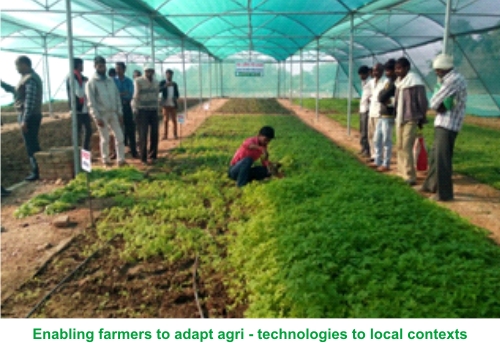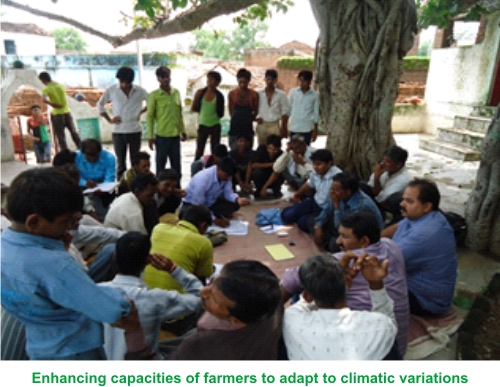Sustainable Agriculture:
Calling for a Plurality of Indicators
Food and nutrition security are possibly the most basic of human needs, yet these continue to be major unmet challenges at the global level. SDG 2, by coupling mandates of food and nutrition security with sustainable agriculture underscores the critical role required to be played by sustainable agriculture in addressing this challenge. The reason that the need for sustainability has now entered the equation is that the agriculture sector over the last few years has been witnessing the ravaging impacts of climate change and the emergence of natural resource constraints linked to over-extraction as limiting factors.
In recent times, there has been much debate
around the idea of singularity – the hypothesis that with the advancement of
technology and especially artificial intelligence, technology has entered a
runaway cycle of self-improvement that will result in unheralded and
unimaginable changes in human civilisation. The scenario of continuous
exponential growth implicit in this debate is a phantasm that recurs across
several sectors, including agriculture. The green revolution in India too
was probably driven by th e
delusion that it is possible to endlessly increase farm production by
applying technologies that allowed for more extractive consumption of
natural resources. The long-term impacts of green revolution being
experienced today serve as a grim reminder that there are, ultimately,
limits to growth.
e
delusion that it is possible to endlessly increase farm production by
applying technologies that allowed for more extractive consumption of
natural resources. The long-term impacts of green revolution being
experienced today serve as a grim reminder that there are, ultimately,
limits to growth.
This brings us to the conclusion that we can no longer afford to equate agricultural development with a single-minded pursuit of productivity – the striving for higher and higher farm production per unit of land regardless of the ecological and social costs involved. The dependence on productivity as the singular measure of success must be replaced with a plurality of indicators that encompass various dimensions of impact including not just the economic but also the ecological and the social, and equally importantly, that throw light on the long-term repercussions of current actions.
Agricultural systems are complex systems, based as they are on natural ecosystems that are characterised by a highly complex and balanced interplay of natural resources, ecological flows and ambient conditions that have evolved over millennia. Natural ecosystems are complex adaptive systems that are regulated through feedback mechanisms and it is this language that we need to tune in to in order to design sustainable management systems. Sustainable agriculture allows us to participate in this system as responsible elements to get optimised (as opposed to maximised) production without destructing the underlying ecological balance.
The diversity of ecological contexts in our country implies that there can be no single model of sustainable agriculture that can be widely adopted as a template solution. This means that sustainable agriculture cannot possibly be understood as a defined package of practices but rather as a set of sustainability principles that need to be applied to the local ecological context. A practice that is considered to be sustainable in a certain context may not be sustainable in a different context.
It is worth underlining the fact that agriculture manifests as an interaction between people and ecosystems, and so, as it is important to understand the dynamics of the ecosystem, it is equally important to understand the manager of this ecosystem, that is the farmer. How the farmer takes farming decisions, how such decisions are influenced by factors such as gender, capacity to invest, ownership of the land, whether they have alternative sources of livelihoods etc. need to be mapped and understood. The application of this understanding will be key in any strategy to influence the wider adoption of sustainable practices in the agriculture sector.
Moreover, we will be doing a great disservice to
the cause of sustainable agriculture if we consider farmers as simply cogs
in the wheel of the agriculture sector or the passive recipient of
technologies, trainings and subsidies. Farmers need to be recognised as
repositories of traditional ecological knowledge and as co-developers of
locally adapted sustainable practices. The measure of sustainability in
agriculture must therefore also include indicators that help capture the
capacities of farmers to adopt, innovate, adapt and disseminate sustainable
practices, especially in response to changing climatic and market contexts
and thereby become more resilient.
The various dimensions of sustainability in agriculture briefly discussed here once again brings us back to the argument made earlier for a plurality of indicators – indicators that consider not just production but also the wellbeing of the farmer and the health of the environment. Even more importantly, the set of indicators used for measuring success must be outcome oriented so that we are able to track whether our actions are leading to the desired impacts. Thus, we must be able to register not just reduction in the use of chemical fertilisers and a corresponding increase in the use of organic manure, but also evaluate if the action resulted in improved organic carbon in the soil. Replacement of flood irrigation with micro-irrigation should be appreciated but true success would reflect in deceleration in the depletion of the water table. Of course, outcomes may be expected only over a longer time horizon, but the tracking systems must already be calibrated for the purpose. The government’s emphasis on raising farmers’ income rather than the agricultural output, as exemplified in the mandate of doubling farmers’ income in the next five years hints at outcome orientation seeping into public policy, atleast in intent, in some aspects.
The importance of outcome tracking is also linked to the complexity of the systems that we are working with. Because development interventions are typically designed to influence a specific part of an integrated system on the basis of an expected cause-effect relationship, they often fail to foresee the impact of other elements of the system or feedback mechanisms in the ecosystem disrupting this anticipated equation. Outcome tracking will alert us to such unexpected or unrealised outcomes and thereby enable us to fine tune the intervention in a manner more integrated with the larger system.
The imperative for diversity extends not just to the indicators but also to the methods by which progress is measured, analysed and reported. Engaging a diversity of stakeholders ranging from the scientist and policy maker to the farmer and the consumer in tracking and assessment is essential for a healthy diversity of perspectives to come in for a holistic sense of progress. This decentralisation of the process may also be expected to bring in the qualitative findings that are as important as the mainstream quantitative analysis to help plug in the gaps in our understanding.
It seems that tracking the adoption and impact of sustainable agriculture will require an overhaul of our measurement systems with a plurality and diversity of indicators that encompass its multiple dimensions and the inclusion of a wider spectrum of stakeholders in the processes. The task at hand is a complex and challenging one and will require the coming together of multiple competencies and disciplines, not to mention intent and commitment. Sure, this will have to be a departure from the rather simplistic measure of productivity that has been driving much of the agricultural sector till now, but as Einstein famously said, “Everything should be made as simple as possible, but no simpler.”■
Mayukh Hajra
mhajra@devalt.org